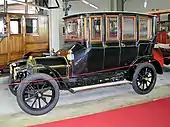Berlin (carriage)
A Berlin (or Berline) carriage was a type of covered four-wheeled travelling carriage with two interior bench seats facing one-another.[1] Initially noted for using two chassis rails and having the body suspended from the rails by leather straps,[2][3] the term continued in use for enclosed formal carriages with two seats after the suspension system changed from leather straps to steel springs.[4]

Origin
_by_shakko.jpg.webp)
The carriage was designed around 1660[5] or 1670[1] by a Piedmontese architect commissioned by the General quartermaster to Frederick William, Elector of Brandenburg.[1][5] The Elector used the carriage to travel from Berlin, Brandenburg's capital, to the French capital of Paris, a distance of 1,054 km (654.9 mi) where his carriage created a sensation.[5] While heavy-duty vehicles had used double-railed frames before, passenger vehicles had normally used a single rail.[3] The elegant but durable style was widely copied and named "berline" after the city from which the carriage had come.[3][2] It was more convenient than other carriages of the time, being lighter and less likely to overturn.[2] The berline began to supplant the less practical and less comfortable state coaches and gala coaches in the 17th century.[4]
British and American sources mention a separate hooded rear seat for a footman detached from the body in their definitions of a berlin carriage, in a similar fashion to a stagecoach.[1][4]
Development
In the 18th century, the steel spring became widely used in carriage suspensions, supplanting the berline's twin-strap suspension system. The term "berline" survived as a description of the formal or ceremonial body style with two bench seats facing each other in a closed carriage.[4]
Smaller carriages mainly for town use were developed from the berline by removing the rear-facing front seat and shortening the enclosure. This style became known as the "halbberline" in Germany and the "berline coupé" (cut berline) in France. The name "berline coupé" was later shortened to "coupé".[6]
Automobile

The berline body style initially carried over from the carriage to the automobile with the chauffeur in the open at the front and an enclosure behind with two seats facing each other as opposed to facing forward. As with the coupé and the brougham, the term evolved with the movement of the driver and controls into an enlarged enclosure, which resulted in turning the front seat to face forward. The term "berline" is now the French term for the saloon or sedan.[7]
See also
Notes
- Chisholm 1911.
- Chambers 1728, p. 97.
- Haajanen 2003, pp. 15–16.
- Haajanen 2003, p. 16.
- Haajanen 2003, p. 15.
- Haajanen 2003, pp. 16, 18, 50.
- Haajanen 2003, p. 17.
References
 This article incorporates text from a publication now in the public domain: Chambers, Ephraim, ed. (1728). "Berlin". Cyclopædia, or an Universal Dictionary of Arts and Sciences (1st ed.). James and John Knapton, et al. p. 0247.
This article incorporates text from a publication now in the public domain: Chambers, Ephraim, ed. (1728). "Berlin". Cyclopædia, or an Universal Dictionary of Arts and Sciences (1st ed.). James and John Knapton, et al. p. 0247.
- Chisholm, Hugh, ed. (1911). . Encyclopædia Britannica. Vol. 3 (11th ed.). Cambridge University Press. p. 791.
- Haajanen, Lennart W. (2003). Illustrated Dictionary of Automobile Body Styles. Illustrations by Bertil Nydén; foreword by Karl Ludvigsen. Jefferson, NC USA: McFarland. ISBN 0-7864-1276-3. LCCN 2002014546.
External links
- Berlin coach Clipart Educational Technology Clearinghouse, University of South Florida. Sketch.
- Günther, Pablo. "The Casanova Tour - Travelling Carriages 2". Casanova Magazine. Archived from the original on 2008-03-15.
- The Long Island Museum of American Art, History & Carriages - Collection Database. Search berlin carriage, record type Objects (photo and text).
- MNC - Colecção: Berlindas National Coach Museum (Museu dos Coches), Lisbon (Portugal). Illustrations and text.
- Музеи Московского Кремля Moscow Kremlin Museum. Photo.